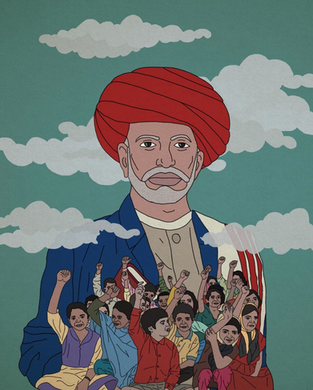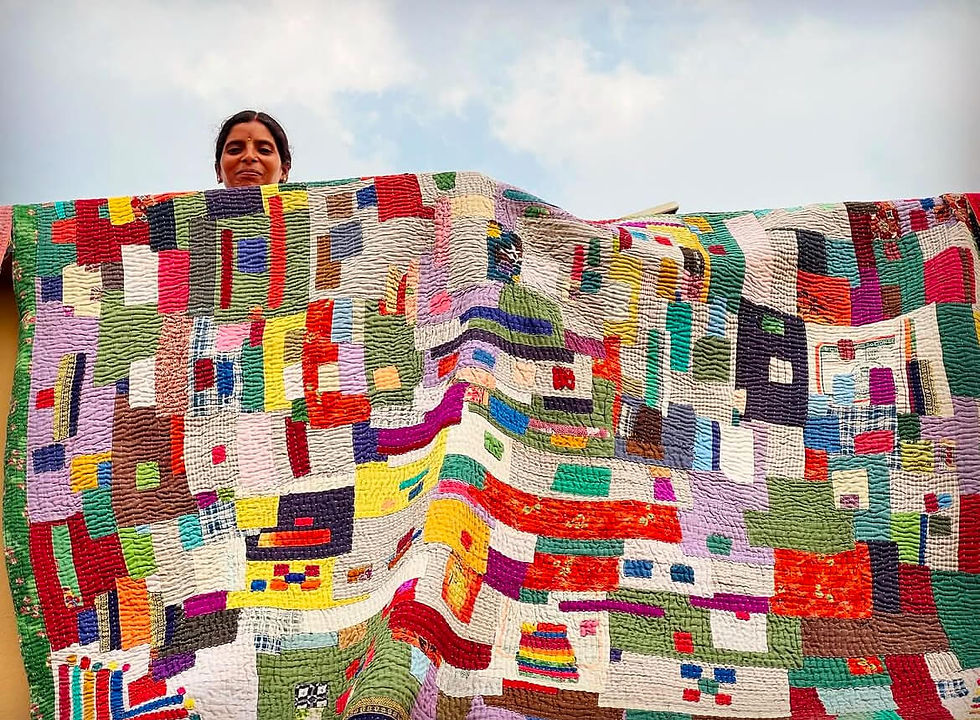Artists for Equality - Dalit Lives Matter
- DEA
- Jun 15, 2020
- 6 min read
Updated: Jan 28, 2021
Written by Aditi Patwari
As the Black Lives Matter movement has gained traction, it has allowed other injustices around the world to come to the surface. One such movement is Dalit Lives Matter in India, which aims to end the caste-based inequalities suffered by a large community of people in the nation. While many Indians have been actively speaking up against the problems in the West, they have become desensitized to the problems in their own country.
A (very) brief history of the caste system: Ancient Hindu texts that informed social norms and structures divided the Hindu society into 4 social classes. This hierarchy classified people and dictated how they would lead their life; the kind of work they would do, the clothes they would wear, and the general part they would play in society based on their social class.
The issue: A community of people were left out of this caste system, which made them dispensable and left them without basic human rights. This community has evolved to call itself Dalit. The crimes committed against Dalits date back to the beginning of Hindu society and even today, the systemic oppression of the community is ingrained in culture and normalized in India.
So this week we are exploring the work of two prominent artists supporting the Dalit Lives Matter movement.
Rahee Punyashloka is a Dalit visual artist, filmmaker, and writer based out of Bhubaneswar and New Delhi, India. His works have been exhibited in numerous festivals, including IFFR, Rotterdam and Tribeca Film Festival, New York.
"Dalit is a self-assertive term used by communities that belong to the untouchable castes originating in the Indian subcontinent. Despite being close to one fifth of India's population, our systemic oppression has kept us almost entirely away from resources and indexes of development." - Rahee Punyashloka
How Many Deaths, How Many Murders, 2020 (Left), Ambedkar Bringing Down a Statue, 2020 (Right)
Image courtesy - Rahee Punyashloka
In his work 'Ambedkar Bringing Down a Statue', Punyashloka pays homage to Bhimrao Ramji Ambedkar, the late Indian economist and social reformer who fought against the social discrimination faced by Dalits.
Punyashloka explains; "While global acts of bringing down statues that were symbols of racism and other forms of oppression ensue, we the Dalits face a deeply perverse reality: not only is the landscape of [India] populated with high profile statues of casteist icons, but, the routine defacement and destruction of statues of Ambedkar... are so frequent that it almost doesn't hurt anymore. This 'frame' that is in the picture is an incomplete one. Hopefully, one day, concrete details of a certain statue would be drawn to the right, and a stream of our people pulling this statue down in unison will be on the left. Till then it's just the lonely figure of Babasaheb, tugging at an invisible enemy that exists outside and above the frame of the picture."
Private Lives of B.R.#2: 'Speech Prepared but Not Delivered' (Left) ,Gulamgiri/Slavery, 2020 (Right)
Image courtesy - Rahee Punyashloka
Punyashloka's Gulamgiri/Slavery is an exploration of Jyotirao Govindrao Phule's anti-caste beliefs. Phule was a social activist and reformer who believed in the equality of all people irrelevant of religion, caste or gender. He and his wife Savitribai Phule played a crucial role in the education of women and Dalits in the 1800s.
Punyashloka says, "[1st June 2020 marked] the 147th anniversary of the publication of Jotirao Phule's Gulamgiri/Slavery which was the first ever definitive declaration of solidarity from within South Asia, toward the African-American descendants of the Trans-Atlantic slave trade. It is also the foundational text of anti-caste critique in colonial modernity, a critique that Phule bases on the assertion that the slavery that Dalit-Bahujan-Adivasi...population of Hindoostan face at the hand of [the caste system] is extremely similar to the African-American experience of slavery.
"Speaking of the recently issued 'Emancipation Proclamation', Phule writes, "[Those at the lowest of the four castes and Dalits] will really appreciate this more than anyone else as they have a direct experience of slavery as compared to others who have never experienced it so. Only slaves can understand what it is to be a slave and what joy it is to be delivered from the chains of slavery". If Phule was alive today, it seems inevitable that his publication of Slavery would be accompanied by the declaration of#blacklivesmatter and have dedications to the memory of Tony McDade, Ahmaud Arbery, Breonna Taylor, and, George Floyd."
Ambedkar Infinity, 2020 (Left), Dharti Aaba, Superhero, 2020 (Right)
Image courtesy - Rahee Punyashloka
"I see myself as part of a set of new and emerging Dalit artists who are working toward creating a new visual culture informed by our own exhaustive intellectual traditions, and away from the representations that continue to dominate mainstream media, that is, as mere symbols of caste based atrocities and violence." - Rahee Punyashloka
Fill in the face, 2020 (Left), Classless and Casteless, 2020 (Middle) Why do we need a Dalit Art Movement, 2020 (Right)
Image courtesy - Siddhesh Gautam
Siddhesh Gautam describes himself as a multi-discipline, mixed-media artist, designer, treasure hunter, fallen angel, and soul searcher. His work is a personification of his personal spiritual journey and he shares it with the world in the hope of inspiring a deeper connection between people through design education. My work is to encourage people to live deeply, love fearlessly, and to appreciate this heavenly place called Earth. His work is meant to challenge your preconceptions, expand your mind, honor the sacred, and evoke feelings of adventure, exploration, and deep spiritual connection.
The artist has been a great influencer in the fight for equality for Dalits. His work both informs and challenges viewers to consider the current unjust situations in India.
Anand against the Republic of caste, 2020 (Left), Mahatma Jotirao Govindrao Phule: The real Mahatma and champion of equal rights for women and Dalits, 2020 (Middle), Cow Raj, India, 2020 (Right)
Image courtesy - Siddhesh Gautam
The artist shares why its important for a Dalit Art Movement right now:
"An Art Movement is a style or tendency in art shared by artists with common ideology, philosophy or goal. Various art movements have emerged in various parts of the world, some were documented globally, some were documented locally (regional and national) and some remained in our memories without any formal documentation.
"The latter is more relevant to us Dalits and Bahujans of Post-modern India. We have, for too long, articulated our rebelliousness against the oppressors of various cults and religious through our artistic expressions in the form of literature, poetry, music and visual art.
"Our art subverts the hegemony, our art intersects and speaks volumes of multiple axes of cultural, social and political injustice and inequality; be it caste, sex, religion, language, region or class.
"Our experiences with art reveals the limitlessness of the sky that we were prohibited to reach for so long. Our vivid imagination does not seek god up above but is a reflection of our domestic synecdoche and aspirations of a postmodern world.
"Enough damage has been caused by the Sanskritization of our art. Enough of our stories have been narrated by [those in the upper castes] and elite Muslims for sympathy. Enough of our poems have been recited by politicians for votes. Enough of our images have been sold by the crony capitalists in the name of philanthropy. We need to create our movement on our own. We ought to document ourselves with our own ink, paint, note, film and tech.
"If we are able to make this a reality, our movement will penetrate where Indian art discourse has not even dared to venture before. But this can not happen with one or a few Instagram/Facebook/Twitter posts. Each of our Dalit-Bahujan humanist has to play their part. We have been practicing our art for centuries and have collected enough agitation... It is our time to organize.
"Let’s come together, discuss and start a movement that has been waiting to breathe for a very long time.
Jai Bhim."
Change is uncomfortable, yet it is necessary to move the world forward. There are beautiful and creative ways artists are sharing their support in the fight for equality. Let us amplify their voices. This week we focused on the important work by artists supporting the Dalit Lives Matter movement, and we will continue sharing other movements around the world.
We are open to your suggestions for other creatives using their voices for good.
Email your recommendations to info@dea-dubai.com
Resources to keep learning and helping the movement: https://dalitlivesmatter.carrd.co/






























Comments